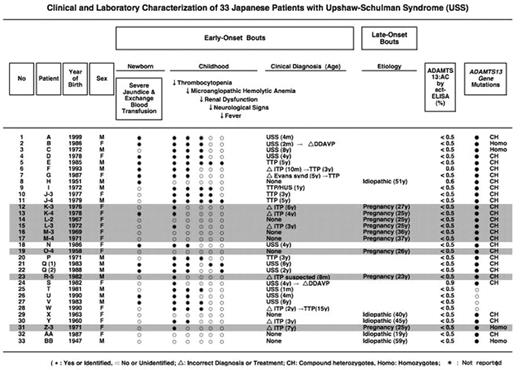Abstract
Upshaw-Schulman syndrome (USS) is a congenital deficiency of the activity of von Willebrand factor (VWF)-cleaving protease or ADAMTS13 due to its gene mutations. USS is a complex thrombo-hemorrhagic disease, but its hallmark is severe neonatal jaundice soon after birth that often requires for exchange blood transfusion, and subsequently during childhood they have repeated episodes of chronic thrombocytopenia and hemolytic anemia that are reversed by infusions of fresh frozen plasma. However, after a discovery of ADAMTS13, the presence of two phenotype expression on USS-patients was described; one is the early-onset type as abovementioned, and the other is the late-onset type which is asymptomatic during childhood and the first bout develops after adolescent or during adulthood, in association with infections or pregnancy. During the past 8 years, we diagnosed 33 patients with USS. Through analyzing the natural history and the phenotype-genotype expression in these patients, and more specifically to 9 USS-patients who had their first bout at pregnancy, we found that two clinical phenotypes of USS are mostly attributable to misdiagnosis or overlook of thrombocytopenia during childhood, and excluded a possibility of the concern on a trace amount of ADAMTS13 activity which has not been evaluated by the previous methods. Further, in vitro studies we have clearly shown that platelet aggregation or thrombi formation under high shear stress is tremendously up-regulated in the absence of ADAMTS13, that occurs proportionally to the amount of high VWF multimers, that in part is assumed to be an in vitro reflection of the circulation in USS-gravida.
Author notes
Disclosure: No relevant conflicts of interest to declare.


This feature is available to Subscribers Only
Sign In or Create an Account Close Modal